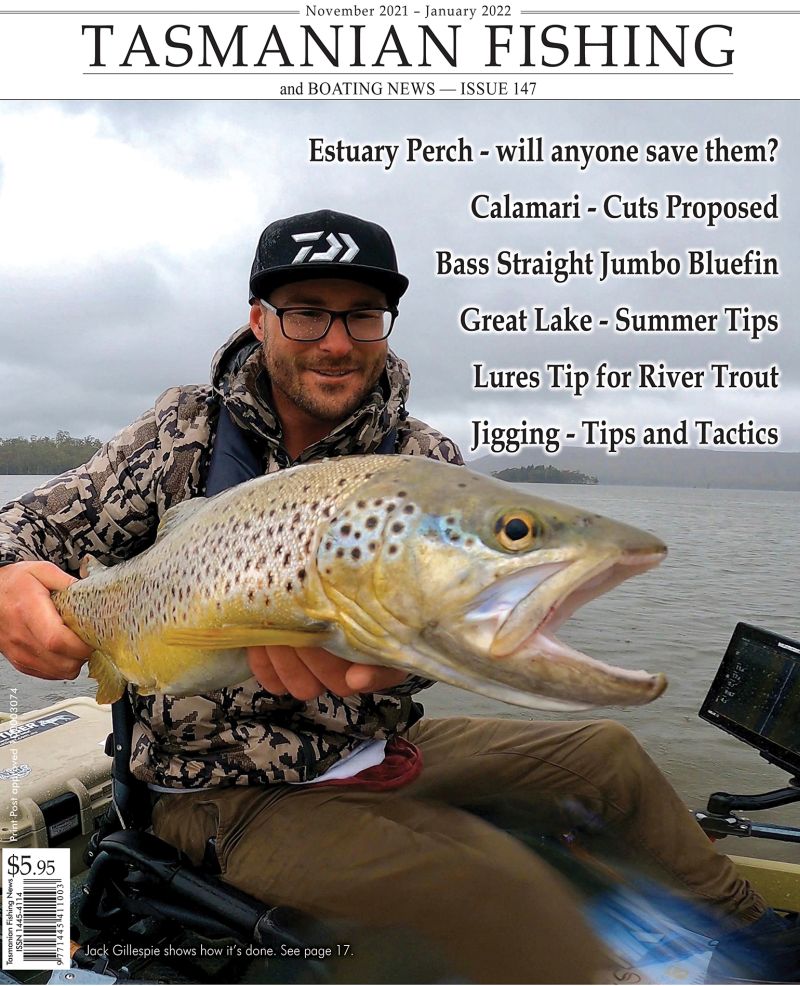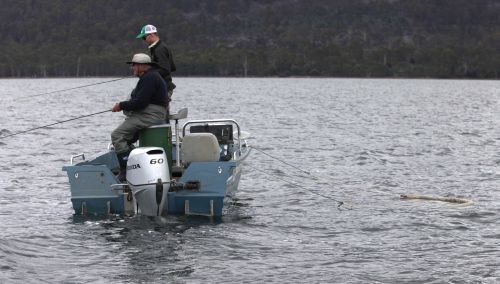From the Archives ...
Fishing on the Wild Side
Fishing on the Wild Side
Mike Fry doesn’t only live on the Wild Side of Tasmania, but also goes fishing in probably the wildest boat ever to troll for trout—certainly in Tasmania.
When your mate says ‘What are you doing tomorrow, want to come up the Gordon for the night?’ it would be pretty hard to say anything else except “you bet” and start checking out your tackle box and packing your overnight bag. But if your mate was Troy Grining and he wanted to give his new 52ft, high speed cruiser a run across Macquarie Harbour, test the new onboard dory with a chance of landing a nice Gordon River Brown you would have to feel privileged. I didn’t say anything about getting on my hands and knees and kissing his feet…just having a lend of ya’ but I did feel very appreciative.
Jan's Flys
This season has been difficult and has really made the fishing population think on how best to catch fish. The weather has been the main contributor in making the fishing quite difficult at times; there was no warmth to speak of until well into the New Year. Mayfly hatches have been spasmodic to say the least, only occurring for short periods and not very often at that.
- Category: Jan’s Flies
- Hits: 4883
Jan's Flies
At the time of putting pen to paper I am sitting in a nice warm spot in the Central Highlands watching the snow creating a white carpet on the ground. It's because of this unsettled weather I have not had time to fish, but I have busied myself reading Greg French's new book Frog Call. I don't consider myself a great reader and it takes something special to hold my attention. This book I love. Many of the stories and places mentioned relate to experiences I've had. Greg talks lovingly about the western lakes area - he makes it sound so magical and is moreso if you have been there. The book is written as short stories and covers many places and often hilarious situations. So for all those interested in fishing, walking and dreaming this is for you.
- Category: Jan’s Flies
- Hits: 5724
Jan's Flies
Sticks, sticks and more sticks - stick caddis that is. Rarely does a trout's stomach contents not contain at least a few stick caddis.
- Category: Jan’s Flies
- Hits: 6205
Jan's Flys
Like most angler anticipation has already set in for what the coming season may bring. The past season was rather hectic for us. We fished a lot of areas, both near and far, and as always if one happened to be in the right place at the right time fish were caught. Always remember the more you fish the more you achieve in learning to catch fish.
- Category: Jan’s Flies
- Hits: 5624
Jan's Flies
by Jan Spencer
Some ten years ago when the World Fly Fishing Championships were held in Tasmania, I was introduced to Loch-Style Fishing. It certainly is an effective style of fishing on the day and it won the English team the gold medal.
I must admit though it really doesn't do much for me. It seems to be that it is little more than fishing a team of wet flies, don't get me wrong, it does catch fish and plenty of them on the right day.
- Category: Jan’s Flies
- Hits: 5953
Jan's Flies
by Jan Spencer
Winter time is a traditional time for fly tying and certainly I have done my share this winter. Winter is also the time for end of the year dinners, always great nights, where many fishy stories are swapped.
- Category: Jan’s Flies
- Hits: 8861
Jans Flies
The days grow shorter and there is a crispness in the air that signals the end of the trout fishing season is getting near. This is a good time for you to reflect on the season that was, like always Bill and I had some wonderful trips and some not so good.
- Category: Jan’s Flies
- Hits: 6470
Jan's Flies - Parachute Flies
Parachute flies are hot on everybody's lips at the moment and they certainly do sit nicely on the water. Next time you are on the water fishing and there is a dun or two around, have a good long look at how they sit. Very nicely, belly down on the water.
- Category: Jan’s Flies
- Hits: 6144
Jan's Flies
The flies in this issue, a Black Nymph, Green Gold Bead Head and Chain Eye Nymph, are normally fished from a boat as the added weight generally makes them too heavy to fish in shallow water. However, they can be fished dead drift under a large buoyant indicator.
- Category: Jan’s Flies
- Hits: 7213
Top Tassie flies for February and March
Jan Spencer talks about her three favourite flies for the coming two months
- Category: Jan’s Flies
- Hits: 6585
Read more: Jans Flies - Top Tassie flies for February and March
Current TFBN
Click above for current issue content. The current issue of TFBN is extensive and topical. In Tackle Stores, Newsagents and by subscription.
Delivered to your door for $48 for 2 years (8 issues). To subscribe, send Mike $48 via www.paypal.com.au . (Basic instructions are here) The email is at Contact Us. Your address will be included from PayPal.
Or phone Mike with your c/c handy on 0418129949
Please ensure your details are correct, for Mike to organise delivery.
TFBN Newsletter Sign up Form
Why not submit an article ?
When you have finished for the day, why not have a brag about the ones that didn't get away! Send Mike an article on your fishing (Click here for contact details), and we'll get it published here. Have fun fishing - tasfish.com
Category Descriptions
Here is a list of all of the Article Categories. The number in Brackets, eg (13) is the number of articles. Click on Derwent River and all articles relating to the Derwent will be displayed in the central area.
Articles by Category
-
Rivers (3)
-
Saltwater and Estuary Fishing (149)
-
Kayak Fishing (34)
-
Lakes (1)
-
Great Lake (62)
-
Lake Leake (52)
-
Woods Lake (16)
-
Lake Augusta (11)
-
Huntsman Lake (13)
-
Lake Pedder and Gordon (10)
-
Lake Dulverton (5)
-
Lake Crescent (6)
-
Tooms Lake (10)
-
Lake Mackintosh (2)
-
Lake Barrington (5)
-
Little Lake (8)
-
Meadowbank Lake (5)
-
Lake King William (7)
-
Lake St Clair (2)
-
Western Lakes (12)
-
Arthurs Lake (35)
-
Lake Echo (7)
-
Four Springs (54)
-
Lake Sorell (7)
-
Lake Burbury (6)
-
Other Lakes (57)
-
Brushy Lagoon (18)
-
Little Pine Lagoon (5)
-
Penstock Lagoon (16)
-
Brumbys Creek (7)
-
-
Events (48)
-
Estuary Fishing (0)
-
Coastal Catches (46)
-
Super Trawler (46)
-
IFS, DPIPWE, MAST and Peak Bodies (435)
-
Commercial Interests (98)
-
Other (24)
-
TFBN Back Issues (8)
-
Fly Fishing (67)
-
Trout Fishing (250)
-
Meteorology and Weather (8)
-
Jan’s Flies (50)
-
Tuna Fishing and other Game Fishing (86)
-
Cooking Fish (19)
-
Fishing Information (1)
-
Fishing Books (8)
-
Videos (5)
-
Tackle, Boats and other Equipment (146)
-
World Fly Fishing Championship 2019 (2)
Popular Tags
windyty.com
Visit https://www.windyty.com/
Rubicon Web and Technology Training
Hello everyone, I thought it would be a good time to introduce myself.
My name is Stephen Smith and I have been managing the website tasfish.com since May 2009.
It has been an epic journey of learning and discovery and I am indebted to Mike Stevens for his help, support and patience.
I am developing a new venture Rubicon Web and Technology Training ( www.rwtt.com.au ). The focus is two part, to develop websites for individuals and small business and to train people to effectively use technology in their everyday lives.
Please contact me via www.rwtt.com.au/contact-me/ for further information - Stephen Smith.
From the Archives ... (last chance)
Tiny creeks and sea run trout - Christopher Bassano
Presented from Issue 105, August 2013
Christopher Bassano fishes over 250 days a year. This interview was recorded just before he headed off to fish for Australia in the World Fly Fishing Championships in Norway 14-17 August 2013.
I live on a small stream and at the start of the season I like to go off on a bit of a discovery mission and fish the headwaters of the creeks and rivers I feel an affinity with.
These small rivers include the St Pats, Meander, Forester, Little Forester and others. The further up you go on these rivers the clearer and lower the levels. They are often less affected by the rain and runoff and you get some good opportunities. Get as close to the source as you can and you will find some good dry fly fishing. Don’t limit yourself to those I have mentioned. Most headwaters will hold trout.
Read more ...


